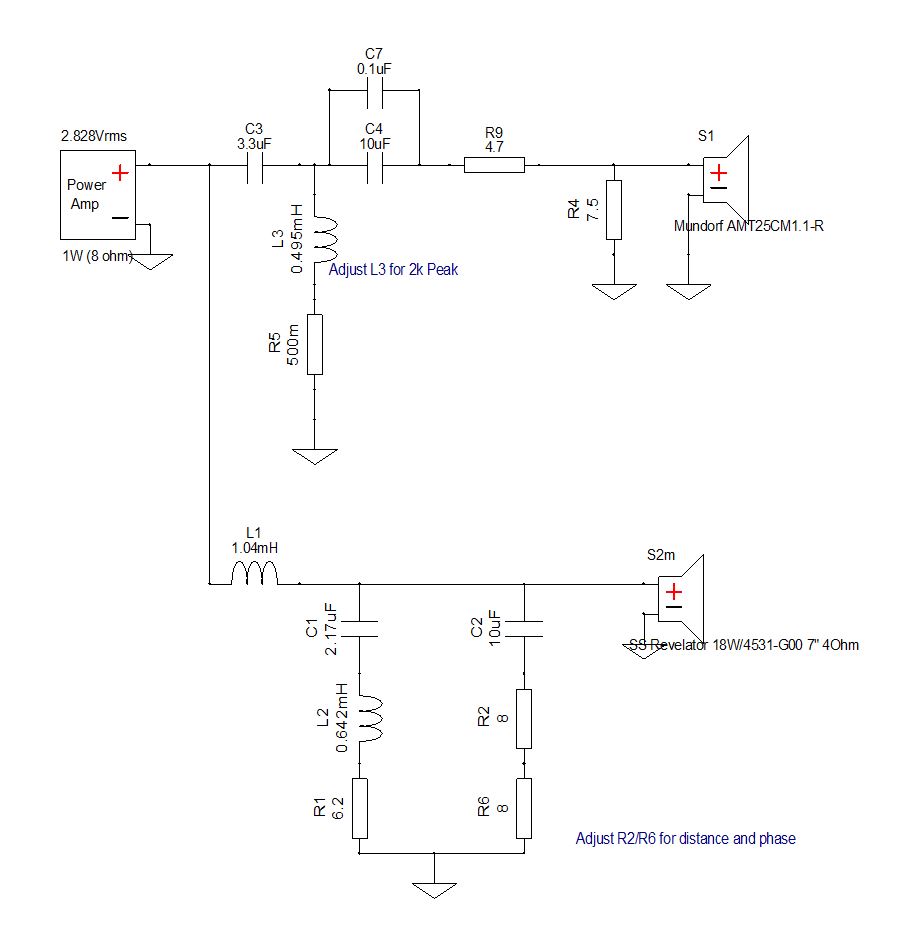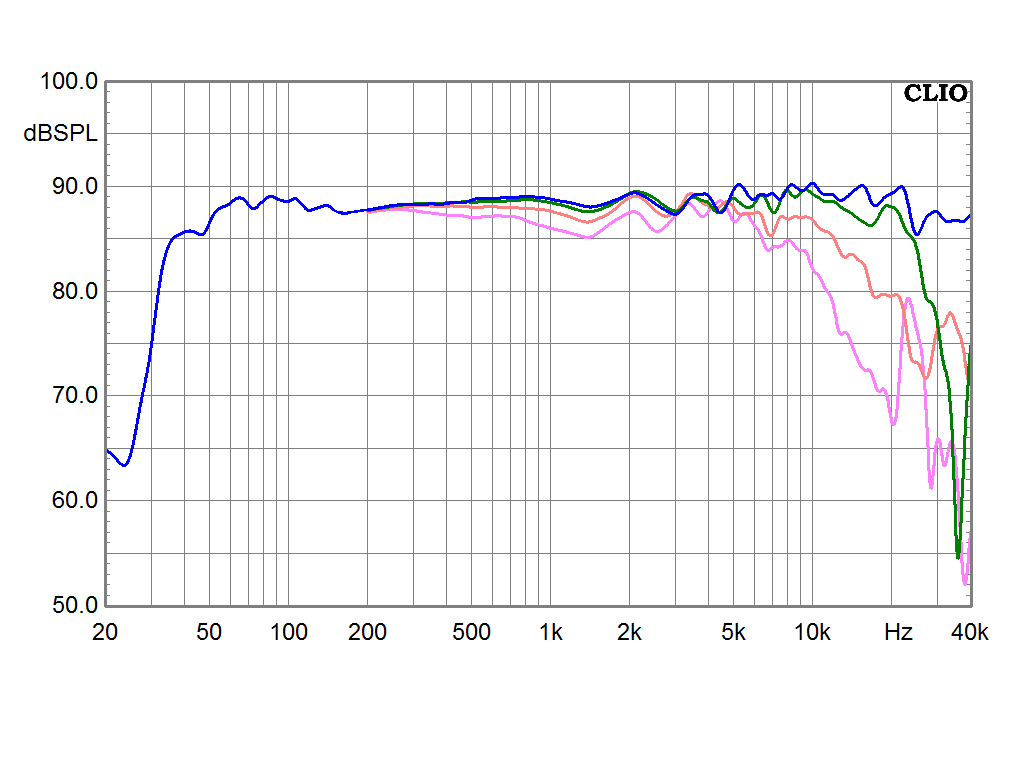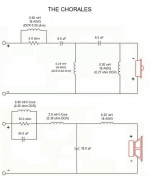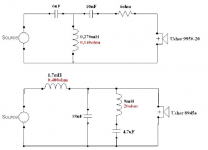The simulator got it right that the woofer response is within 1 db for most, actual room gives more like +/- 3db.
but no 4 db bump at 50 hz, not measured or observed.
Simulator would suggest a 8ohm instead and a 2.1 Input inductor.
However listening test proved 10ohm 2.4 a lot better for high frequency.
For the tweeter:
The filter with 7.5 ohm actually corrected the dip in the tweeter response, with no filter the impedance is not 2 ohm it is 0 ohm in the simulator.
More filter with more impedance would make the tweeter sound not equal.
The response that you see is close to the final design which I can't pin-point in the 50 simulations I did 🙂.
It is from 2 meters off-axis and gives a great sound, sweep tones are quite controlled.
I just say that the actual XO is surprising if you look what I would come with in the simulator to correct the bumps which are not measured in real life.
I admit the tweeter is very badly simulated... lack of data
I am quoting this because we are turning the page.
It's dreadful, my friend. 😱
The frequency response matters not one whit, because I am just using any old 6" driver and a tweeter. The low impedance is an amp-killer!
The bass filter dips to 10 ohms at high frequency with the 10R resistor shunted to ground by the 13uF capacitor. Entirely unnecessary.
The bass filter doesn't actually do much, and could be greatly simplified. The third order is quite a nice idea in that it flattens the response from the driver well.
It's the tweeter filter that is the real horror. It's causing most of the impedance dip. It is also overly peaky at crossover. I can't redesign this for you, because I don't have the modelling or an exact idea of the relative levels of the two drivers, but it can be much better.
You need to lose the attenuator, and put some resistance in front of the tweeter filter. Then adjust the crossover. I wouldn't be surprised if something like 4.7R and 4.7uF in series with a 0.2mH shunt would do the right things.
12 element crossover. Not much damping getting through that maze. I've seen 18 element crossovers to screw around the FR till it looks nice.
I had a high-school math teacher who used to say, "Give me 7 variables and I can draw a graph looking like an elephant. Give me 8 and I can make it wag its tail."
Very different kind of performance when you bi-amp and use DSP after installing the sub(s) in the best performing location(s) in the room.
B.
I had a high-school math teacher who used to say, "Give me 7 variables and I can draw a graph looking like an elephant. Give me 8 and I can make it wag its tail."
Very different kind of performance when you bi-amp and use DSP after installing the sub(s) in the best performing location(s) in the room.
B.
Are you bored, Ben? 🙄
Gabdx, I've rustled up a couple of circuits for these Usher drivers. The woofer is a clone of that scruffy looking scan 18W. Which I have heard. The 90dB tweeter is much flatter than PE would have us believe.
8945A – USHER
9950-20 – USHER
Troels has a go at the Scanspeak 18W/8542-00 here:
18W/8542-00/
Looks like it's always 2kHz crossover with (guesses) a presence notch around 800Hz.
I think you could do something here. I'm getting the idea, for sure.
Gabdx, I've rustled up a couple of circuits for these Usher drivers. The woofer is a clone of that scruffy looking scan 18W. Which I have heard. The 90dB tweeter is much flatter than PE would have us believe.
8945A – USHER
9950-20 – USHER
Troels has a go at the Scanspeak 18W/8542-00 here:
18W/8542-00/
Looks like it's always 2kHz crossover with (guesses) a presence notch around 800Hz.
I think you could do something here. I'm getting the idea, for sure.
Attachments
12 element crossover. Not much damping getting through that maze. I've seen 18 element crossovers to screw around the FR till it looks nice.
I had a high-school math teacher who used to say, "Give me 7 variables and I can draw a graph looking like an elephant. Give me 8 and I can make it wag its tail."
Very different kind of performance when you bi-amp and use DSP after installing the sub(s) in the best performing location(s) in the room.
B.
So you're more of an active rather than passive crossover guy?
I do admire a (passive) crossover where topology choices mean components kill 2 birds with one stone (double duty if you will). In my own, I try to remove components or change to achieve the same effect. Mainly to save money, as I don't understand enough about electrical behaviour to understand your point about "not much damping getting through that maze".
I can understand extra circuitry (typically parallel or series notches / compensation) being required for
- Impedance compensation (mainly for tube amps this seems? I don't know enough to tell if you have a "Decent" S/S amplifier, whether constant load provides sonic benefit. Happy to be enlightened).
- FS resonance (where crossing over higher is difficult)
- Driver breakup (where crossing lower or steeper is difficult)
In my latest 3 ways - actually removing a parallel notch proved beneficial for phase tracking between mid and tweeter and only reduced attenuation by 10 dB of the breakup (nominally 45 dB down instead of 55 dB with the notch). so removing had a benefit.
Are you bored, Ben? 🙄
Gabdx, I've rustled up a couple of circuits for these Usher drivers. The woofer is a clone of that scruffy looking scan 18W. Which I have heard. The 90dB tweeter is much flatter than PE would have us believe.
8945A – USHER
9950-20 – USHER
Troels has a go at the Scanspeak 18W/8542-00 here:
18W/8542-00/
Looks like it's always 2kHz crossover with (guesses) a presence notch around 800Hz.
I think you could do something here. I'm getting the idea, for sure.
Hi Ben,
I agree with your observations of my XO, it is terrible in many ways.
The hard truth is that I wasn't able to come with a better solution. I started this project at least 5 years ago I tried all the XO possible until I got the drastic idea of the 2.5mh with 10R bypass to boost the low end and tame the 2Khz of the woofer which is very bad.
I tried all values of 1st to 4th order and none would do, I tried conjugate filters, parallel filters, which would impart the sound elsewhere.
The tweeter was giving me a dip in the response and this weird filter was the only thing to bring up the frequency response around 3k-4k.
I posted MY frequency response and it is good (to me) and also super nice on the ear. (xo curves, xo point at 2200hz is very regular and responses of individual drivers are very linear)
I tried many types of amplifiers on those, they survived🙂
However next speakers will be better designed, my point was to show that the predicted response of simulators is way off when you build the actual speakers.
Simulators with actual driver response also doesn't work. It is only a starting point.
Last edited:
I don't understand enough about electrical behaviour to understand your point about "not much damping getting through that maze".
Could this be the loopback impedance?
In an active bi-amp system the amp directly sinks any back-EMF, but with passive crossovers at certain frequencies the back-EMF cannot get back to the amp at all and there may not be other passive components to dissipate it.
System7, you are right.
I will need more modelisation of the XO with softwares.
This is so disapointing that my measuring microphone cannot pick up the peak. The in-room 1 to 2 m measure looks almost ok, but after a few months, there is two things:
1. soprano at around 2khz I guess shouts too loud.
2. I have an issue listening violins in the mix of an orchestra, this is annoying. I think around 600 to 800 hz lies the problem
I will need more modelisation of the XO with softwares.
This is so disapointing that my measuring microphone cannot pick up the peak. The in-room 1 to 2 m measure looks almost ok, but after a few months, there is two things:
1. soprano at around 2khz I guess shouts too loud.
2. I have an issue listening violins in the mix of an orchestra, this is annoying. I think around 600 to 800 hz lies the problem
I thought this idea from eriksquires was rather good:

SNR-1 : Mundorf / Scanspeak 2 Way
He's just using a single coil with a 5(?) kHz notch and a bit of impedance correction to help the response. It ends up around 3kHz crossover which is doable with most tweeters. Seems a good idea with these difficult scanspeak type 6" woofers.
SNR-1 : Mundorf / Scanspeak 2 Way
He's just using a single coil with a 5(?) kHz notch and a bit of impedance correction to help the response. It ends up around 3kHz crossover which is doable with most tweeters. Seems a good idea with these difficult scanspeak type 6" woofers.
@Gabdx: It is questionable how much indoor measurements give realistic picture. Here are measurements with same equipment at 1m distance of the same loudspeaker. Quasi-anechoic with gate of 10ms (outdoors) and 4.5ms (indoors)

In room measurement looks ok but outdoors shows how it really is or as close to that as possible.

In room measurement looks ok but outdoors shows how it really is or as close to that as possible.
Last edited:
I thought this idea from eriksquires was rather good:

That's clearly the Irish Elk of crossovers.*
B.
* Behringer DCX2496 the all-singing all-dancing DSP, about $200
Last edited:
Traditionally, discussion of the cause of their extinction has focused on the antler size (rather than on their overall body size), which may be due more to their impact on the observer than any actual property.
Irish elk - Wikipedia
Irish elk - Wikipedia
Complex XO are only bad if you can hear resonances. Many parts is more a good thing than not, more variables means more control and issues in case some part doesn't do what you want.
Going with behringer and some microphone in room falls into many traps.
1. Makes vinyl useless and pointless
2. uses digital manipulation in 1 dimention based on flawed room readings.
3. Makes any "hifi" gear pointless due to the use of 'mainstream approved' opamps and circuits.
This can be a good or bad thing, depending on the user.
To be back on the subject, Esriksquires has a brilliant idea, at priori with my limited understanding, to use a lowish L1 and brillant! place the filter after it. In normal XO you have such filter before. For this type of speaker this is a great solution.
Going with behringer and some microphone in room falls into many traps.
1. Makes vinyl useless and pointless
2. uses digital manipulation in 1 dimention based on flawed room readings.
3. Makes any "hifi" gear pointless due to the use of 'mainstream approved' opamps and circuits.
This can be a good or bad thing, depending on the user.
To be back on the subject, Esriksquires has a brilliant idea, at priori with my limited understanding, to use a lowish L1 and brillant! place the filter after it. In normal XO you have such filter before. For this type of speaker this is a great solution.
Last edited:
With two speakers you have 28 xover elements (not counting 4 drivers and 2 boxes and stuffing and ports) which many DIY builders have no means to measure to see if they are anywhere near their spec (including the drivers and boxes and stuffing and ports and room) and including a bunch of very crude and suspicious electrolytic capacitors. Gimme a break.
In 2018, sure makes more sense to have active crossovers and bi-amp with near-perfect but cheap amps. And if your crossover happens to be a DSP*, whoopee.
B.
*What's the problem using DSP with vinyl and tube amps (even without bi-amping)... prolly a great improvement, eh.
In 2018, sure makes more sense to have active crossovers and bi-amp with near-perfect but cheap amps. And if your crossover happens to be a DSP*, whoopee.
B.
*What's the problem using DSP with vinyl and tube amps (even without bi-amping)... prolly a great improvement, eh.
Last edited:
it is true that there is a lot of oversimplification of the XO. 5uf sounds different than 5.2uf in critical places of the XO, but most parts are within 5% = can be 10% mismatch with L/R which can ruin an XO. You literally need shelves of inductors to build something, some 0.2R can change the XO point too...
Drivers should be matched at factory before purchase, this is possible too for most diy shop will do this for you.
I see some diyers outperforming commercial designs so it is not out of reach.
I have a DSP dac in my new computer and on an external EMU for DJ's, this is not the sound I am looking for, although it can play tetris 1989 theme well.
Interesting fact: if you listen to a rock song, it has probably 5% thd from the speakers/room of the studio, and an added 5% for sound console effects reverb/pan/mixing. You play this back home on your 2%thd hifi speakers in your 5% thd room, your DSP which has 0.01% and your perfect amp which has 0.001% is not significant in the equation.
Drivers should be matched at factory before purchase, this is possible too for most diy shop will do this for you.
I see some diyers outperforming commercial designs so it is not out of reach.
I have a DSP dac in my new computer and on an external EMU for DJ's, this is not the sound I am looking for, although it can play tetris 1989 theme well.
Interesting fact: if you listen to a rock song, it has probably 5% thd from the speakers/room of the studio, and an added 5% for sound console effects reverb/pan/mixing. You play this back home on your 2%thd hifi speakers in your 5% thd room, your DSP which has 0.01% and your perfect amp which has 0.001% is not significant in the equation.
Last edited:
MurphyBlaster Productions
I just tried today without measurements the above XO.
I think I now have a better idea of what is going on.
First, the bass on the driver in my configuration and moreover in closed box is missing in the 60 - 100 hz , this I compensated with the 2.4mh but had to add a 10ohm bypass to keep some high frequency.
However the peak at 900hz was not addressed and is better addressed in the link above of murphyblaster.
The filter he did cannot be integrated to my 3r order xo, I would have to redesign it almost from scratch. However even with his filter the 900hz peak is still there audibly

The bass also is lower with the only 1.25 inductor and I have a passive radiator to help, still not present enough.
Just by ear the tweeter is not going high enough but integrates "ok" by listening only, so to me the filter for the tweeter is affecting the upper frequency 10khz over. In my xo most of it was preserved in listening.
To address the amp question, my EL34 amp with 16 watts at 0.25% thd had no issue driving it , it has only 5db of GNF.
I just tried today without measurements the above XO.
I think I now have a better idea of what is going on.
First, the bass on the driver in my configuration and moreover in closed box is missing in the 60 - 100 hz , this I compensated with the 2.4mh but had to add a 10ohm bypass to keep some high frequency.
However the peak at 900hz was not addressed and is better addressed in the link above of murphyblaster.
The filter he did cannot be integrated to my 3r order xo, I would have to redesign it almost from scratch. However even with his filter the 900hz peak is still there audibly


The bass also is lower with the only 1.25 inductor and I have a passive radiator to help, still not present enough.
Just by ear the tweeter is not going high enough but integrates "ok" by listening only, so to me the filter for the tweeter is affecting the upper frequency 10khz over. In my xo most of it was preserved in listening.
To address the amp question, my EL34 amp with 16 watts at 0.25% thd had no issue driving it , it has only 5db of GNF.
to conclude, the filter on the link of murphyblaster fixes 3 things:
Get the proper response.
Address the 900hz peak
Preserve the 'violin' sound perfectly with the lower inductor of 1.25.
Fix the impedance to prevent killing amplifiers.
The result to me just listening to it:
1. bass response is a lot weaker
2. violins can now be heard but they lack air
3. tweeter response is not extended but seems to integrate ok with woofer
4. Peak at 900hz is still very present, even tamed the lack of bass makes this a lot worst to my ear.
Made no difference in my amplifier driving 7 ohm vs 2 ohm dip.
Satisfaction with my XO was 80%, now it is 60% with the above XO
Get the proper response.
Address the 900hz peak
Preserve the 'violin' sound perfectly with the lower inductor of 1.25.
Fix the impedance to prevent killing amplifiers.
The result to me just listening to it:
1. bass response is a lot weaker
2. violins can now be heard but they lack air
3. tweeter response is not extended but seems to integrate ok with woofer
4. Peak at 900hz is still very present, even tamed the lack of bass makes this a lot worst to my ear.
Made no difference in my amplifier driving 7 ohm vs 2 ohm dip.
Satisfaction with my XO was 80%, now it is 60% with the above XO
Finaly system 7, the 1mh bass inductor 2n order from your suggestion is out of question because of the bass issue.
2n order doesn't work with the driver which is very difficult to tame in the 2khz region
2n order doesn't work with the driver which is very difficult to tame in the 2khz region
Sorry if I'm hijacking this thread but Im building Samuel HQ speakers by Heissmann Acoustics that have these measurements and I wonder what your opinion is :

To me it looks pretty good?

To me it looks pretty good?
- Status
- Not open for further replies.
- Home
- Loudspeakers
- Multi-Way
- Crossover: Staying within 3dB

